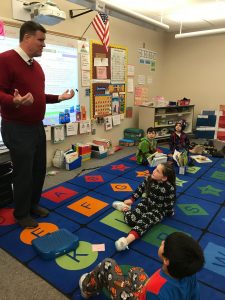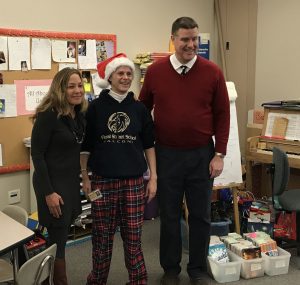Posted by kavery508 | Posted in Uncategorized | Posted on January 1, 2018

![]() James Mann via Compfight
James Mann via Compfight
Happy New Year! I hope your holidays were filled with joy (and warmth!). I spent mine visiting with family members from far away, catching up with friends, and yes, whittling away at the old work pile. Onward into the new year!
Our CAFE focus this week is on Inferring, which is a strategy we use all the time to help us understand what we’re reading. When we infer, we use our schema (what we already know about something) and combine it with clues from the text to understand something new. Consider these lines from Eloise Greenfield’s poem Things: Went to the beach/Played on the shore/Built me a sandhouse/Ain’t got it no more. My schema tells me that at the beach we build sandcastles, which is what she likely means, and sometimes the ocean comes and washes them away–that’s why the speaker “Ain’t got it no more.” Kids and grownups infer all the time in real life, for example: Snow is in the forecast. When the phone rings at 5:30 AM we can infer school will be delayed or cancelled! It’s smart to catch it when it happens and ask “How did you infer that? What were your clues?” Here is a site that, while designed for teachers, has lots of great info and links on inference: http://www.minds-in-bloom.com/2012/02/tips-for-teaching-inference.html
 Having learned strategies for multiplying 2s and 5s (skip counting; finger counting; dot paper), we now apply them to multiplying 10s. In addition, we will review the commutative property (e.g. 10 x 2 = 2 x 10) while stressing the need to model these correctly when solving problems. We will then learn to use multiplication of 2s (repeated addition of groups of 2) to learn odd and even numbers. Students will be taught to group objects by 2s and if there is none left over then it is even; otherwise it is odd. Likewise, if you can split a group cleanly in half with no leftovers, that also means it is an even number. Learning it like this helps students to understand the nature of odd and even as opposed to only applying tricks (e.g. it’s even if it ends with 0, 2, 4, etc.).
Having learned strategies for multiplying 2s and 5s (skip counting; finger counting; dot paper), we now apply them to multiplying 10s. In addition, we will review the commutative property (e.g. 10 x 2 = 2 x 10) while stressing the need to model these correctly when solving problems. We will then learn to use multiplication of 2s (repeated addition of groups of 2) to learn odd and even numbers. Students will be taught to group objects by 2s and if there is none left over then it is even; otherwise it is odd. Likewise, if you can split a group cleanly in half with no leftovers, that also means it is an even number. Learning it like this helps students to understand the nature of odd and even as opposed to only applying tricks (e.g. it’s even if it ends with 0, 2, 4, etc.).
 As we continue our exploration of weather, students will conduct daily observations of temperature, clouds, and weather type over the next month. We will then analyze the data, look for trends, evaluate methods for presenting data (e.g. bar graphs vs. pie charts for example), and draw conclusions of winter weather in Shrewsbury. In addition, this week we will conduct an investigation around evaporation to answer the question “Where does the water go?”. We will also learn to identify cloud types and use that to predict the weather. Weather Wiz Kids is a fantastic site for learning more about and all things weather. And here’s a favorite, Bill Nye the Science Guy, teaching about how clouds are formed.
As we continue our exploration of weather, students will conduct daily observations of temperature, clouds, and weather type over the next month. We will then analyze the data, look for trends, evaluate methods for presenting data (e.g. bar graphs vs. pie charts for example), and draw conclusions of winter weather in Shrewsbury. In addition, this week we will conduct an investigation around evaporation to answer the question “Where does the water go?”. We will also learn to identify cloud types and use that to predict the weather. Weather Wiz Kids is a fantastic site for learning more about and all things weather. And here’s a favorite, Bill Nye the Science Guy, teaching about how clouds are formed.
Here’s our superintendent, Dr. Sawyer, and representatives of the Shrewsbury Education Foundation informing us of my award–I was surprised and honored!




